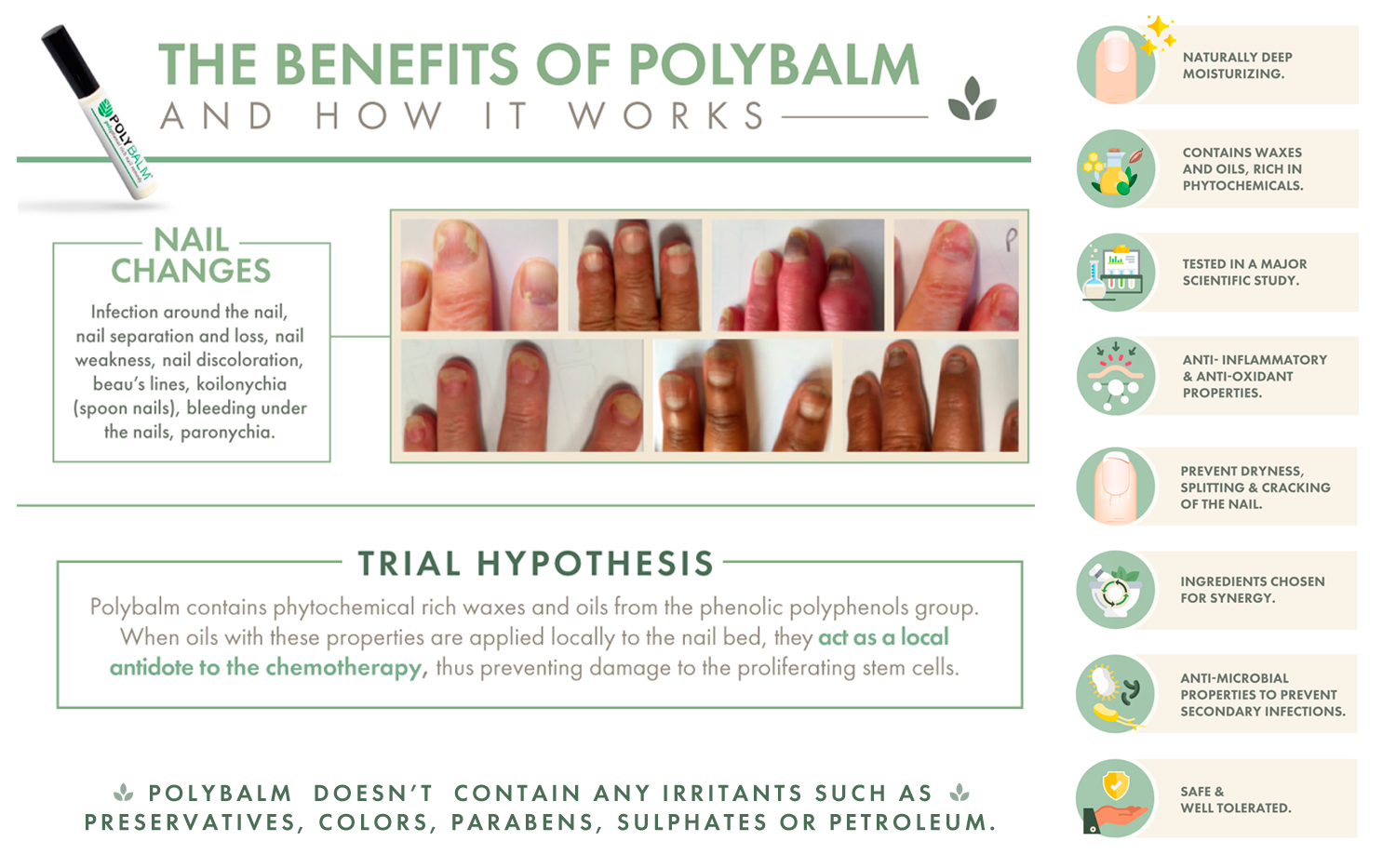Nail Changes During Cancer Treatment & How Polybalm Can Help
Nail Changes During Cancer Treatment & How Polybalm Can Help
Dr. Singhal Strongly Recommends Using Polybalm When Undergoing Chemotherapy or Any Other Type of Cancer Treatment That Causes Damage to Your Nails
Nails are made by living stem cells. Stem cells are a rapidly dividing kind of cells. This means that nails are very susceptible to changes caused by chemotherapy because chemotherapy can “confuse” them with cancer cells. As a consequence, nail damage is common, particularly following regimens containing taxanes used for men and women with breast and prostate cancer. Anthracyclines, such as doxorubicin (Adriamycin) and epirubicin (Ellence) can also cause damage to the nails, as well as Cyclophosphamide (Cytoxan).
Nail Changes During Cancer Treatment
The type of damage can vary a lot from a person to person. Damage to the nails can include anything from Beau's lines, koilonychia (also known as “spoon nails”), paronychia, nail discoloration, redness and swelling of the nail bed, bleeding under the nail, infection, nail separation and splitting, to even a complete loss of the nail. We made an infographic (see below) to help you recognize and name any change you notice to your nail.
The Only Science-Backed Nail Health Solution
Most of these changes can be prevented or at least minimized and partially fixed. Dr. Singhal has searched for the best product to help cancer patients or non-cancer patients with damaged nails to achieve and maintain healthy, good looking nails throughout their chemotherapy or radiation. The product that surfaced as the best one, sub-par, is Polybalm.
Polybalm is the ONLY natural nail solution to be scientifically designed, developed and assessed in a major government-backed randomized double-blind controlled trial (RCT). It contains rare plant-based waxes and biologically active essential oils which have been skillfully made to keep their rich polyphenolic active composites. Polybalm doesn’t contain any irritants such as preservatives, colors, parabens, sulfates or petroleum.
Polybalm Is The Only Nail-Remedy Scientifically Proven To Help
Polybalm is short for polyphenol-rich natural balm. It was created by oncologists and dermatologists from Cambridge University Hospital in the United Kingdom together with cosmetic, biological and natural scientists from Coventry and London Universities in association with the National Cancer Research Institute’s lifestyle and behavioral change committee. Several hundred potential candidates have been reviewed, to choose four oils and four bases for their individual properties and synergy with each other. The bases included cold-pressed extra virgin olive oil, organic beeswax, unrefined cocoa butter, and unrefined organic shea butter. The essential oils covered Gaultheria procumbens, lavandula officinalis, eucalyptus globulus, tarchonanthus camphorates.
How Does Polybalm Work?
The waxes and oils in Polybalm are especially rich in phytochemicals, notably the phenolic polyphenols group. They are proven to have anti-inflammatory and anti-oxidant properties. Oils with these properties, applied locally to the nail bed, absorb to act as a local antidote to the chemotherapy, inhibiting damage to the proliferating stem cells. Their anti-microbial properties help limit secondary infection so overall keeping the nail healthy and uninjured.
How Should You Use Polybalm?
Polybalm can be used by anyone who is interested in having healthy strong nails. Polybalm is not a quick fix remedy. The benefits will only be seen after a couple of weeks of use as the nails grow slowly so advances to the health of the nail bed will only be seen when the nails grow out.
PolyBalm Tutorial - How to Apply Polybalm
Keeping The Nails Healthy
Alongside using Polybalm, this is what you can do to keep your nails healthy even during chemotherapy:
Clip the nails regularly, so they don’t split, which can induce more damage. Clear debris from under the nails and around the nail beds to remove any fungus and bacteria.
Use gloves when handling cleaning products. Nail polish remover can irritate the nails so try to avoid excessive use.
Protect your hands from cold. Wear gloves.
Keratin bonds in the nails break down when nails are dry, causing splits and cracks. Moisturizing is very important on a regular basis.





